You're using an outdated browser. Please upgrade to a modern browser for the best experience.
Please note this is a comparison between Version 2 by Sirius Huang and Version 1 by Changyang Guan.
The driving range of electric vehicles (EVs) is still an important factor restricting their development. Although the rising battery energy density has reached a bottleneck, which is a key constraint, the drive energy management strategy also has a significant effect and can improve the driving range of EVs. Herein, the typical configurations of the dual-motor coupling drive system (DCDS) are introduced, and the power distribution strategies of the DCDS are comprehensively reviewed.
- electric vehicle
- energy efficiency
- power management
- independent drive
1. Introduction
Electric vehicles (EVs) are considered to be a significant solution to reduce air pollution caused by the transportation industry due to their zero-emission characteristics [1,2,3][1][2][3]. Meanwhile, EVs are also considered to be the best platform for autonomous vehicles because of their excellent control performance. However, the inadequate driving range of EVs is still a crucial constraint to their development [4]. The means to improve the driving range of EVs can be roughly summarized as design means and control means. The design means mainly refer to the design of the batteries, motors, and body structure of EVs, which are considered to be the fundamental means to increase the driving range of EVs. The control means mainly refer to the control of the vehicle subsystems, such as the braking system, steering system, and active suspension system, which could directly or indirectly reduce the driving energy, and they are generally quick-acting and effective means for improving the driving range of EVs.
2. Dual-Motor Coupling Drive System
The multi-motor coupling drive system (MCDS) is an electrical drive system that incorporates multiple motors coupled through a mechanical structure. This kind of drive system can optimize the working points of each motor by distributing power, torque, and speed among multiple motors to achieve energy conservation. Over the years, the MCDS has received widespread attention due to its energy conservation potential. Since two motors can almost fully release the energy conservation potential of the MCDS and more motors would not significantly improve the energy-saving effect due to possible increases in mass and cost, most of the research on MCDSs in recent years has focused on the dual-motor coupling drive system (DCDS). Therefore, this chapter mainly focuses on the DCDS.2.1. Configuration of DCDS
There are three types of DCDSs based on their power coupling patterns: the dual-motor torque-coupling drive system (DTCDS), the dual-motor speed-coupling drive system (DSCDS), and the variable dual-motor coupling drive system (VDCDS). Each type has distinct configurations. A characteristic of the DTCDS is that its output torque is the linear summation of the output torque of the two motors, and its output speed is proportional to the output speed of the two motors. Based on this characteristic, the efficiency of the DTCDS can be improved by distributing the output torque of the two motors to optimize the working points of each motor [21,22][5][6]. For a typical DTCDS, the output ends of the two motors are connected through a specially designed coupler or directly connected to the same element (Figure 1) so that the output torque of the drive system can be transferred freely between the two motors. Moreover, the DTCDS can switch between single-motor driving mode and dual-motor torque-coupling driving mode to reduce the transmission loss caused by the idle rotation of the non-driving motor, which can further improve the energy conservation potential of the DTCDS. This can be achieved through the utilization of clutches and the matching design of mechanical structures such as the reducer and coupler [23][7]. In addition, since torque coupling is the simplest power coupling pattern, the configuration of the DTCDS can be diverse. Broadly speaking, in addition to the typical DTCDS introduced above, the front-and-rear-independent-drive axle is also a kind of DTCDS.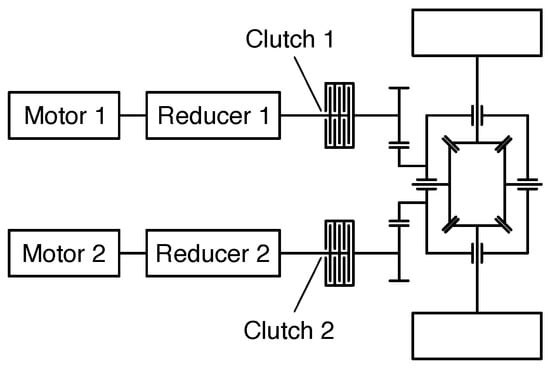
Figure 1.
Schematic of typical DTCDS.
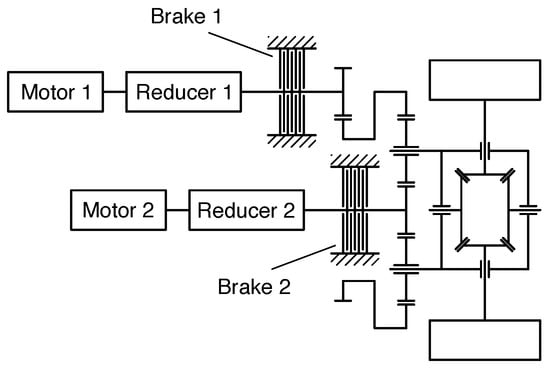
Figure 2.
Schematic of typical DSCDS.
Table 1.
Comparison of DTCDS and DSCDS.
| DCDS Configuration | Coupling Output Torque | Coupling Output Speed | Feasible Driving Modes |
|---|---|---|---|
| DTCDS | Linear summation of the output torque of the two motors | Proportional to the output speed of the two motors | Single-motor drive mode and dual-motor torque-coupling driving mode |
| DSCDS | Proportional to the output torque of the two motors | Linear summation of the output speed of the two motors | Single-motor drive mode and dual-motor speed-coupling driving mode |
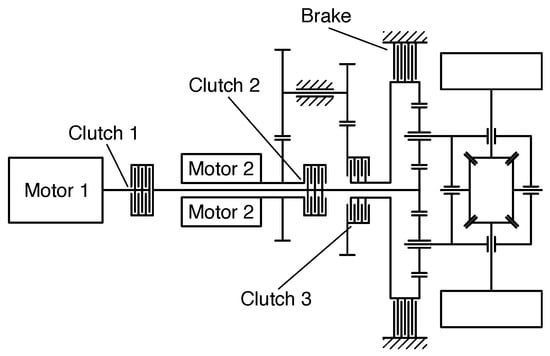
Figure 3.
Schematic of a novel VDCDS.
2.2. Power Distribution Strategy of DCDS
To tap into the energy-saving potential of the MCDS, a power distribution strategy is essential. The primary objective of a power distribution strategy is to optimize the distribution of output power from each motor, which aims to enhance the efficiency of the drive system without compromising its performance. As shown in Figure 4, for the DCDS, the main effect of a power distribution strategy is the optimization of the working points of two motors, resulting in an effective improvement in the load of the motors. This ensures that the working points of the motors can operate more within the high-efficiency area of the motors, thereby improving the driving efficiency of the DCDS.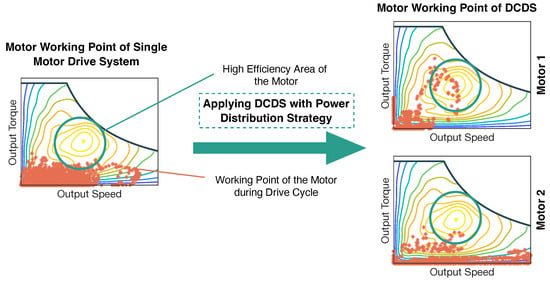
Figure 4.
Working point optimization schematic of motors with power distribution strategy in DCDS.
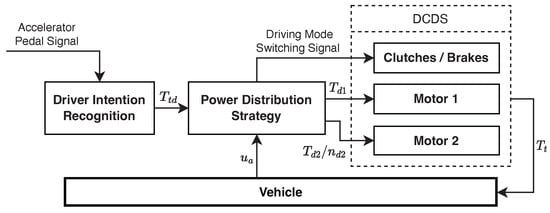
Figure 5.
Typical power distribution control system of DCDS.
References
- Chan, C.C.; Wong, Y.S. The state of the art of electric vehicles technology. In Proceedings of the 4th International Conference on Power Electronics and Motion Control, Xi’an, China, 14–16 August 2004; pp. 46–57.
- Hofmann, J.; Guan, D.; Chalvatzis, K.; Huo, H. Assessment of electrical vehicles as a successful driver for reducing CO2 emissions in China. Appl. Energy 2016, 184, 995–1003.
- Zhan, W.; Wang, Z.; Deng, J.; Liu, P.; Cui, D.; Li, H. Analysis of influencing factors of carbon emission reduction in the driving stage of electric vehicles based on big data. Automot. Eng. 2022, 44, 1581–1590.
- Ali, A.M.; Moulik, B. On the role of intelligent power management strategies for electrified vehicles: A review of predictive and cognitive methods. IEEE Trans. Transp. Electrif. 2022, 8, 368–383.
- Hua, Y.; Zhang, J.; Wen, X. High power Dual Motor Drive System used in Fuel Cell vehicles. In Proceedings of the 2008 IEEE Vehicle Power and Propulsion Conference, Harbin, China, 3–5 September 2008.
- Sorniotti, A.; Holdstock, T.; Everitt, M.; Fracchia, M. A Novel Clutchless Multiple–Speed Transmission for Electric Axles; University of Surrey: Guildford, UK; Warwick, UK; Volume 2, pp. 103–131.
- Hu, J.J.; Zheng, L.L.; Jia, M.X.; Zhang, Y.; Pang, T. Optimization and model validation of operation control strategies for a novel dual-motor coupling-propulsion pure electric vehicle. Energies 2018, 11, 754.
- Coronado, P.D.U.; Ahuett-Garza, H. Analysis of Energy Efficiency and Driving Range of Electric Vehicles Equipped with a Bimotor Architecture Propulsion System; Center for Innovation, Design and Technology, Tecnológico de Monterrey, Campus Monterrey: Monterrey, Mexico, 2014; Volume 6, pp. 152–177.
- Wu, X.; Yin, X. Control of a dual-motor coupling drive system on electric vehicles buses. Chin. High Technol. Lett. 2013, 23, 863–867.
- Zhang, C.; Wu, X.; Wang, Z.; Tian, Z. Mode switching control strategy of dual motors coupled driving on electric vehicles. J. Beijing Inst. Technol. 2011, 20, 394–398.
- Sun, D.; Chen, Z. Parameters matching and design of dual-drive electric vehicle transmission system under NEDC working conditions. Intern. Combust. Engines 2013, 4, 22–25, 39.
- Zhang, S.; Xiong, R.; Zhang, C.N.; Sun, F.C. An optimal structure selection and parameter design approach for a dual-motor-driven system used in an electric bus. Energy 2016, 96, 437–448.
- Wang, Y.; Sun, D.Y. Powertrain matching and optimization of dual-motor hybrid driving system for electric vehicle based on quantum genetic intelligent algorithm. Discrete Dyn. Nat. Soc. 2014, 2014, 11.
- Hu, M.H.; Zeng, J.F.; Xu, S.Z.; Fu, C.Y.; Qin, D.T. Efficiency study of a dual-motor coupling electric vehicles powertrain. IEEE Trans. Veh. Technol. 2015, 64, 2252–2260.
- Wang, J.; Liu, D.; Zhang, Y.; Sun, W.; Chu, L. Analysis of energy conservation potential of novel pure electric vehicle with dual motors configuration. J. Jilin Univ. 2016, 46, 28–34.
- Zhang, S.; Xiong, R.; Zhang, C.N. Pontryagin’s minimum principle-based power management of a dual-motor-driven electric bus. Appl. Energy 2015, 159, 370–380.
- Meng, X.; Wang, R.; Xu, Y. Torque distribution strategy of pure electric driving mode for dual planetary vehicle. J. Zhejiang Univ. 2020, 54, 2214–2223, 2246.
- Zhang, S.; Zhang, C.N.; Han, G.W.; Wang, Q.H. Optimal control strategy design based on dynamic programming for a dual-motor coupling-propulsion system. Sci. World J. 2014, 2014, 958239.
- Gao, Y.; Wang, W.; Li, Y. Optimization of control strategy for dual-motor coupling propulsion system based on dynamic programming method. In Proceedings of the the 3rd Annual Academic Meeting of Vehicle Control and Intelligence Professional Committee of China Association of Automation, Beijing, China, 21–22 September 2019.
- Wahl, H.-G.; Gauterin, F. An iterative dynamic programming approach for the global optimal control of hybrid electric vehicles under real-time constraints. In Proceedings of the 2013 IEEE Intelligent Vehicles Symposium (IV), Gold Coast, QLD, Australia, 1 December 2013.
- Larsson, V.; Johannesson, L.; Egardt, B. Analytic solutions to the dynamic programming subproblem in hybrid vehicle energy management. IEEE Trans. Veh. Technol. 2015, 64, 1458–1467.
- Lin, C.; Zhao, M.J.; Pan, H.; Shao, S. Energy management for a dual-motor coupling propulsion electric bus based on model predictive control. In Proceedings of the 10th International Conference on Applied Energy (ICAE), Hong Kong, China, 22–25 August 2018; pp. 2744–2749.
- Zhang, C.N.; Zhang, S.; Han, G.W.; Liu, H.P. Power management comparison for a dual-motor-propulsion system used in a battery electric bus. IEEE Trans. Ind. Electron. 2017, 64, 3873–3882.
More
